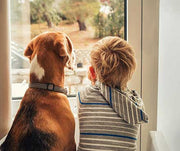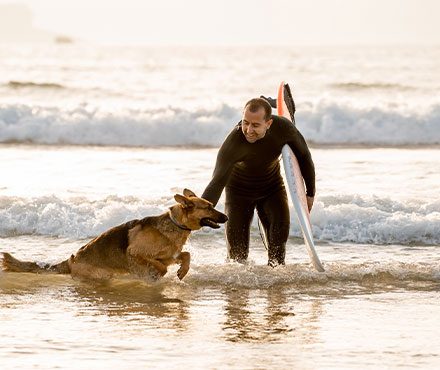Fire Safety for Dogs

According to a fact sheet from the American Humane Society, over 500,000 pets are affected by house fires each year. To add insult to injury, it is estimated that about 1,000 fires are started by pets themselves.
You likely have a fire safety plan in place for you and your family (if you don't, now is a great time to start drafting one), but it's incredibly important to ensure that any contingency or evacuation plan takes your pets into consideration. In this article, we will be outlining the basics of fire safety for dogs, fire prevention tips, and how to include your canine family members in your safety plan.
Basic Fire Prevention Tips
As your grandmother might have told you growing up, "an ounce of prevention is worth a pound of cure." The key to any fire preparedness plan is ensuring your house or apartment is a safe environment for your family members and pets, free of fire hazards.
Make Sure Smoke Detectors are in Working Order
Smoke alarms are an easy way to protect your family and pets. At the very least, you should have at least one smoke detector in each story of your home, with at least one alarm in every bedroom or sleeping area.
We all recognize the dreadfully annoying beep that signals a smoke detector's low battery levels. Smoke alarms are outfitted with a device that emits a high-pitched chirping sound to signal the need for replacement. If silencing the constant beeping isn't enough of an incentive to replace the batteries, the thought of increasing everyone's chances of survival in the case of a fire certainly should be. In fact, it's often recommended to replace the batteries before your smoke detector reaches endless beeping status. A good rule of thumb is to replace the batteries at least twice a year, or every six months.
In addition to replacing the batteries, it's important to perform regular maintenance tests to ensure that your smoke detectors will actually notify you in the event of a fire. Check the alarm for signs of dust or any other substances that may have accumulated, so you can clear any blockage.
Place Fire Extinguishers in Common Areas
Always be sure to have multiple fire extinguishers available in the home at all times. For starters, we recommend having one fire extinguisher each in your kitchen, garage, and laundry room, as those rooms tend to house the most fire hazards. It's also a good idea to keep a fire extinguisher in your living or entertainment room, especially if you have a fireplace.
Always Supervise Open Flames
When you think of open flames, you might picture a bonfire, campfire, or a fireplace on a cold winter's night. Candles, however, deserve extra emphasis. As innocuous as they might seem and as pleasantly fragrant as they might be, candles are an extremely common fire hazard, causing approximately 15,600 house fires per year. Dogs can be curious creatures and may be keen to investigate the burning flame, so be sure to keep all candles out of reach of pets (and children).
Depending on your dog's personality, it may be wise to avoid candles altogether, or at least in areas of the home where your dog is allowed. A hyperactive dog who exhibits random bursts of energy is more likely to knock things off of tables and furniture, including burning candles.
If your home has a fireplace, consider opting for an enclosed model. Fireplace enclosures not only keep your dog from inching too close to the flames but also prevents the risk of flying embers or sparks.
Don't forget the kitchen! Cover or remove stove knobs, especially if you have a larger or taller dog, as accidental nudges can set things alight.
Practice Proper Electrical Safety
It's important to secure any and all cords and keep them out of your dog's reach, especially in areas with lots of electronics, such as your entertainment room or home office. It's no secret that dogs love to chew and are glad to gnaw on anything they can get their paws on (especially teething puppies). Be sure you provide your pup with plenty of chew toys to keep them busy, especially for instances when you're away from home.
Create a Fire Safety Plan
Now that we've outlined several fire prevention basics, it's time to get to the bread and butter: creating a detailed safety plan.
Account for Situations in Which You're Not Home
Most safety plans tend to include instructions for evacuation when you are present. Unfortunately, house fires run on their own schedule and have every ability to start when you are not home.
If possible, try to keep your dogs in an area that is close to an entrance or exit, especially if they are confined to a certain room or area of the house when you are away. This way, when emergency personnel arrives, your dogs have an easier exit route. Be sure to keep leashes by the door and ensure that all pets are wearing ID tags with your current contact information, even if your dog is microchipped. On that note, if your dog is not already microchipped, it may be a good idea to consider the procedure.
You may need to secure puppies in a crate but be advised that this approach requires much consideration and forethought. It's essential to keep mischievous puppies away from fire hazards when they are left unsupervised. Exercise Pens are another great option to keep puppies out of trouble and confined to one space.
If you are securing a puppy while you are away, make sure they are kept in a room with access to an exit.

Use a Pet Alert Sticker
Buy a pet alert sticker to display near your front door or whatever serves as the primary entrance to your house. These can alert first responders to how many pets are in the house and where emergency personnel may be able to find them. Be sure to take note of areas in which your dog likes to sleep or lounge.
Pack an Emergency Kit
Put together an emergency kit with a leash, carrier, any medication, and a copy of your dog's vaccine and medical records. It's a good idea to have a dedicated leash and carrier (depending on the size of your dog) specifically for your emergency preparedness kit. This ensures all of your emergency supplies are in one place and ready to grab in the event where a quick evacuation is necessary.
In the Event of a Fire
In the event of a fire emergency, attempt to gather your pets and exit the house as quickly as possible, reinforcing the need to have leashes or carriers readily within reach at all times. If you are unable to quickly locate your pets or they are out of reach, protect yourself and leave, as difficult as it may be. Never endanger yourself or your family by remaining in the house to look for a pet. Most of the time, pets can sense danger themselves and will find their own way to exit. Once you exit, it is critical that you never go back inside a burning house. Once emergency personnel arrives, immediately notify them that your pets are still inside.
We hope that these fire safety tips have encouraged you to create a fire emergency preparedness plan for you and your dog if you haven't already. Take the time to map out each step, as it is always better safe than sorry.
Previous article

Next article

Related posts
View all-

Activities To Do With A Dog That Loves Water
Some dog breeds seem to be happy to play in the water all day if you let them. For these pups, there are plenty of summer activities that will keep them entertained. Here are examples you can do with a dog that loves to splash and play in the water. Read Article -

How to Get My Cat to Use His Scratching Post
Many cats prefer scratching furniture over a post, leaving their owners frustrated with shredded sofas and clawed-up carpets. But don’t worry—getting your cat to use a scratching post instead of your couch is possible with the right approach.
Read Article -

How to Get My Cat to Stop Using My Chairs as Scratching Posts
If your cat is turning your dining chairs into their personal scratching post, you’re not alone. Many cats scratch furniture, and while it’s frustrating, it’s also completely normal. Scratching isn’t just about sharpening their claws—it’s how cats stretch, mark their territory with scent glands, and relieve stress.
Read Article



